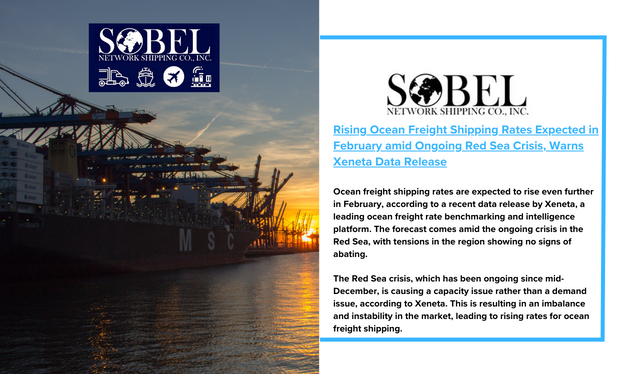Ocean freight shipping rates are expected to rise even further in February, according to a recent data release by Xeneta, a leading ocean freight rate benchmarking and intelligence platform. The forecast comes amid the ongoing crisis in the Red Sea, with tensions in the region showing no signs of abating.
The Red Sea crisis, which has been ongoing since mid-December, is causing a capacity issue rather than a demand issue, according to Xeneta. This is resulting in an imbalance and instability in the market, leading to rising rates for ocean freight shipping. Early indications suggest that these rates will continue to increase in early February, based on data already received from customers for the first week of the month.
The crisis has already caused a 243 percent increase in short-term rates from the Far East to the Mediterranean, with a market average of $6507 per FEU. Rates from the Far East to North Europe have also risen by 235 percent since mid-December, with an expected eight percent increase by February 2, bringing the market average to $5106 per FEU. The biggest increase in rates is from the Far East to the U.S. East Coast, with an expected 17 percent rise to $6119 per FEU, a 146 percent increase since mid-December.
According to Peter Sand, Chief Analyst at Xeneta, carriers are trying to adjust services to make up for the additional sailing time around the Cape of Good Hope. This includes cutting journeys short, missing port calls, and increasing sailing speed. However, despite these efforts, the early data suggests that rates will continue to rise in February.
Sand also noted that carriers are no longer offering the most expensive premium services, which guarantee freight will be shipped during periods of extreme pressure on available capacity. This could be due to a waning demand for this level of service or the availability of capacity, despite the chaos caused by carriers pausing transits through the Suez Canal.
The missile strikes by the U.S. and UK against Houthi militia in Yemen have only added to the heightened tensions in the region, causing further disruption to ocean freight shipping. Xeneta warns that if the situation does not calm down, disruptions will continue to increase, causing delays and rising costs for consumers.
While tension in the Middle East is not uncommon, the current crisis in the Red Sea is expected to last for months rather than weeks or days. Sand believes that it is unlikely to escalate to the same level as the crisis in the Strait of Hormuz. However, the longer the crisis continues, the more it will impact ocean freight shipping and the global supply chain.
In conclusion, the ongoing crisis in the Red Sea is causing a capacity issue that is leading to increased rates for ocean freight shipping. Early data from Xeneta suggests that these rates will continue to rise in February, and the longer the crisis persists, the more it will disrupt the global supply chain.


